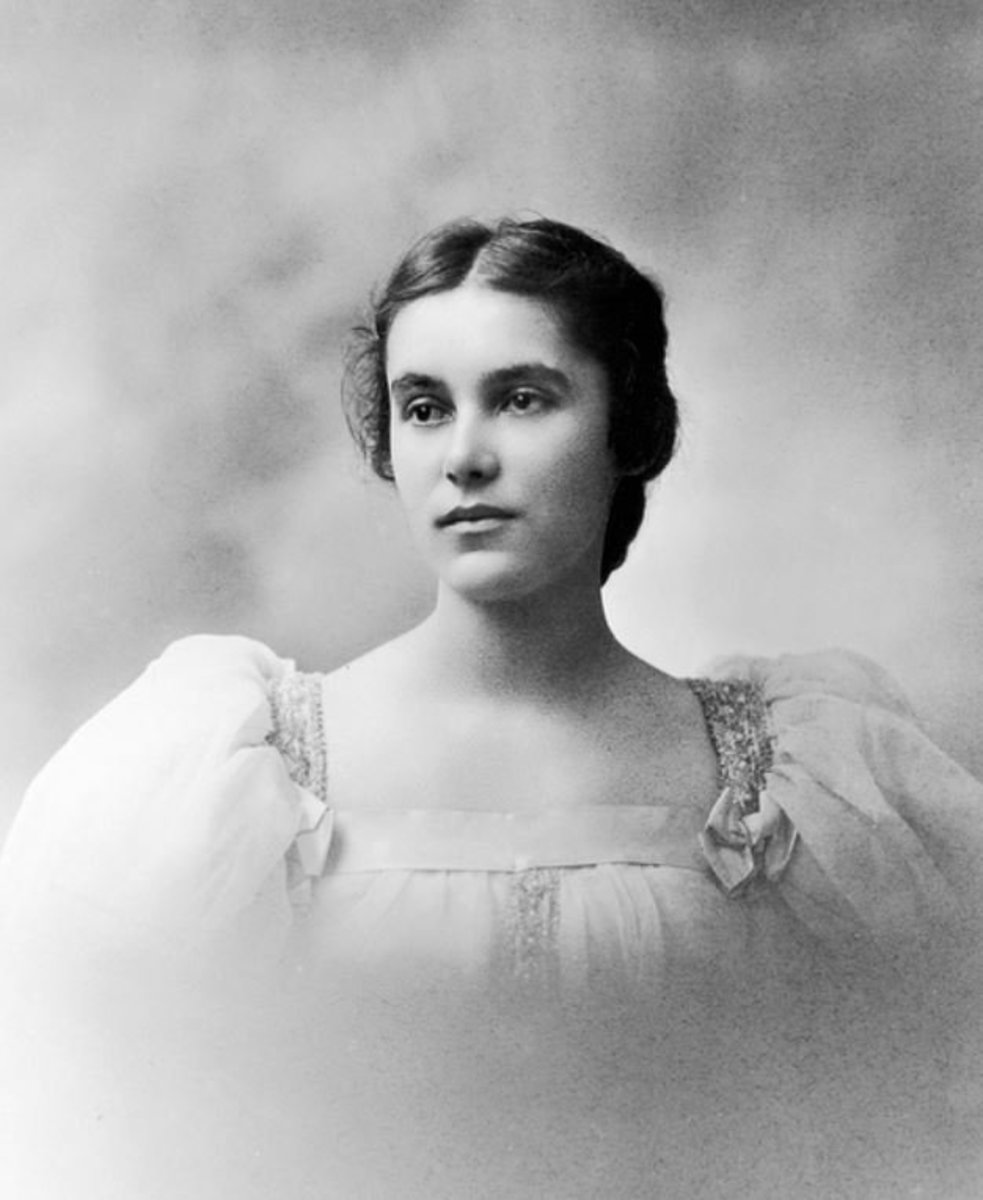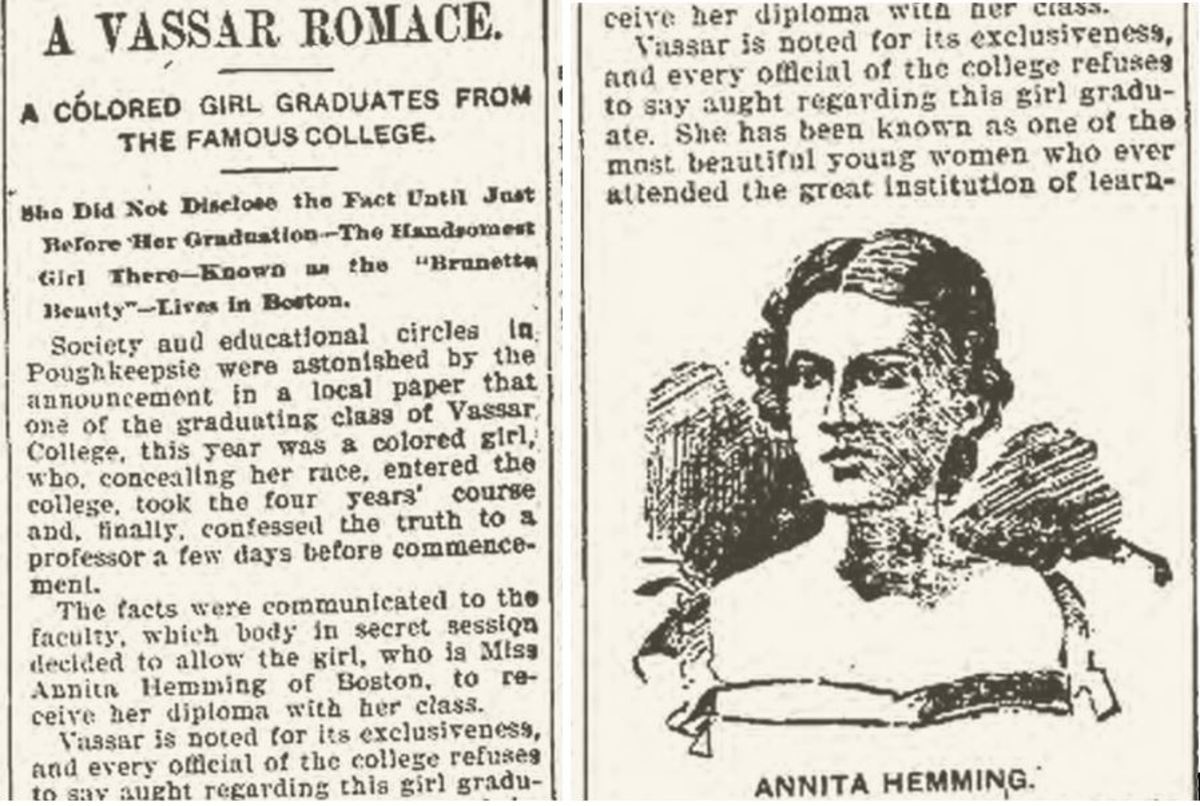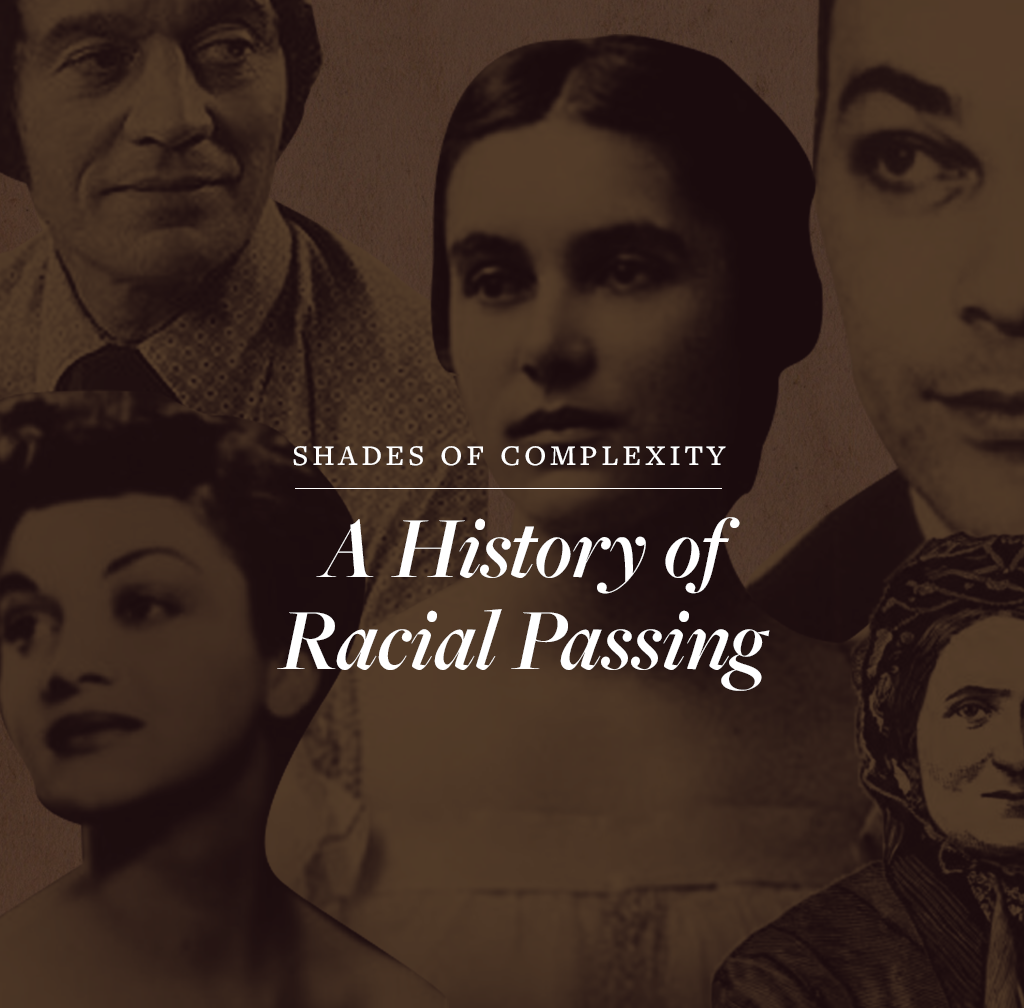BEAUTIFUL ANITA HEMMING. STORY OF THE VASSAR GRADUATE BORN OF NEGROES.
The Sacramento Daily Record-Union
Friday, 1897-09-24
page 6, columns 1-4
Source: Chronicling America: Historic American Newspapers. Library of Congress.
STORY OF THE VASAR GRADUATE BORN OF NEGROS
She Kept the Secret of Her Birth for Years From Her Roommate.
This is the story of Anita Hemming of Vassar, ’97. In all the news of the past week there has been nothing more dramatic than the story of this woman and the sudden revelation of the secret she had kept so well, says the New York “World.” The public was told that one of the most beautiful, the most brilliant, and the most charming graduates of this year’s class at Vassar was a negro girl. The public was intensely interested, but to no one did the revelation come with such over whelming surprise as to the classmates with whom Miss Hemming had been so closely associated for four years. In no mind, until very recently, had there been the slightest suspicion of the truth.
The story of Miss Hemming’s college life and of the influences and characteristics that made her what she is will be told here. There is interest in it, as well as a moral lesson. There is inspiration, too, in the splendid triumph of this young woman who came into life so heavily handicapped for the career she has achieved. These are the things that she has done. How she has accomplished them and the manner in which she has surmounted all obstacles will be told in detail later on.
In 1888 she was graduated from the Prince Grammar School, Boston, at the head of her class.
In 1890 she completed, with the highest honors, the full course of the Girls’ English High School in Boston.
Subsequently she attended Dwight L. Moody’s School, at Northfield, Mass., and there prepared for the entrance examination of Vassar, astonishing her teachers and associates by her brilliant work.
In 1893 she entered Vassar, from which she has this year been graduated with high honors.
During her four years at college she was a prominent and brilliant figure in the life of the great institution. She became a leader among the girls, a member of the most exclusive college societies, a guest in the best Poughkeepsie families, and the idol of a large following of enthusiastic freshmen. She was lovingly called “the beautiful brunette.” It was supposed that she had Spanish or possibly Indian blood in her veins. No one dreamed that in a little, modest Boston home there lived an honest mulatto who was the father and a prepossessing mulatto woman who was her mother. Both of these were light in color, with the mixed blood of their race, regular features and a clear olive complexion which many a white woman would give much to possess.
To these parents Anita was born twenty-five years ago. Her father was a clever and industrious man. He worked hard, and almost from the beginning he was able to give his family the advantages offered by the average white husband and father of the middle class. Anita had a happy childhood. She was sent to school, where she associated with the white children of her age. At this time there was no effort made by her parents to conceal the negro strain in her blood. It was probably the unconscious shrinking away from her of some playmate that first taught the colored child her own aloofness and showed her that she must make much of life’s journey alone. The thought did not discourage the ambitious little girl, who quietly laid out the plan of life which she has so consistently followed. In her wish for an education she had her father’s affectionate support and aid. She entered the Prince Grammar School in Boston, where she is still remembered as one of its brightest pupils. At the end of two years, during which she easily distanced all of her associates, she graduated at the head of her class. This honor secured her entrance to the Girls’ English High School, for four years she gained new laurels and wore them modestly.
Just at this time she met the woman who has probably had most Influence in the young girl’s life. The woman was a philanthropist. She had broad sympathies and keen observation. She met Anita at Trinity Church, Boston, where the girl had been a communicant since childhood. The clear-headed and sympathetic woman of the world be came deeply Interested in the beautiful colored girl who was making such a steady, brave, up-hill fight against environment and tradition. She suggested college, and in the contemplation of this vista, of delight Anita almost forgot her peculiar relations to the world of ideas, achievements, and white skins. She entered Moody’s preparatory school at Northfield, and it is at this point that her career may be said to have really begun. She was at this time a girl of twenty, with a beautiful face, a splendid intellect, and a habit of retrospection. Her parents mingled wholly with their colored friends, and her home life had brought her into contact with the people of her own race. The line between her and the life she wished to lead seemed very sharply drawn. There was nothing about her, however, to suggest her negro blood. Her skin was a clear olive, her eyes soft and dark, and her hair straight as an Indian’s, her figure and carriage perfect. She looked like a Spanish or Italian girl.
At Northfield Miss Hemming first had the experience of associating intimately with girls not of her own race. Her roommate there, however, was a Miss Bessie Baker, a mulatto like her self. Miss Baker has since become the wife of W. H. Lewis, a well known negro citizen of Boston, who was known in his college days as Harvard’s great center rush. Miss Hemming was bridesmaid at the wedding, which occurred last autumn. She is now the guest of Mrs. Lewis in the latter’s home on Columbus Avenue, Boston.
During the year at Northfield the two colored girls were closely associated with the social as well as the educational life at Mr. Moody’s school. Strangers looking at either of them had no suspicion of the presence of a strain of negro blood. Their classmates seemed to have forgotten it. The happy life there and the temporary absence of the cloud that had hung over her may have aided Miss Hemming in her resolve to enter Vassar without the great handicap which she had carried so long. She determined to conceal the fact of her negro origin. This implied no false statements. She had merely to let it be assumed that she was as the others were.
Miss Hemming entered Vassar. No one asked her whether she was negro or New Englander, Indian or Spanish. She was young, brilliant and beautiful. That was enough. She had passed an excellent entrance examination. She had met the necessary requirements as to “good moral character.” She promptly and quietly took her place at the head of her classes, friends flocked around her, professors praised her, she was initiated into the mysteries of secret societies and midnight “fudge” parties. Her college career had begun.
For almost a year she kept her secret well. Then she suddenly disclosed it. Perhaps it weighed upon her mind, and she told it to obtain relief. Perhaps the disclosure was accidental. No one knows. But the girl chose her confidant wisely. She told her story to a member of the faculty–one of the most popular professors in the college. This woman’s attitude toward her brilliant pupil may be assumed from the fact that she subsequently visited Anita at her Boston home during the holidays. The Hemming’s were humble people, and they made no effort to conceal the fact from the college professor who was their guest. Their friends and associates were colored people. There was no pretense of being white.
With the exception of this friend Miss Hemming entertained no guests from Vassar in her Boston home. The professor, like Anita, kept the secret well. Anita’s roommate was a beautiful and popular student, whose family held a high social position. Not even this girl suspected the truth for years. When she did Anita’s first great trouble came. Miss Hemming’s progress through Vassar was a triumphal one. She had a beautiful voice, hence she joined the glee club. She was also taken into the choir and became a leader in the musical set of the college. She joined the choral club. As the months passed she was made a member of other college associations. Among these were the Contemporary Club, the ’97 Federal Debating Society, a Greek club, and the Marshall Club. But these were not all her triumphs.
There are dances and festival days at Vassar. in which Harvard, Yale and Princeton men are allowed to participate. In large numbers these young men bowed at Anita’s shrine. It was a their bows with an agonized fear. She sobriquet by which she became renowned–“the beautiful brunette.”
It was her roommate who finally caused the temporary downfall of this striking figure from its fine college eminence. In some manner this girl had discovered that Anita was of negro parentage. She immediately changed her room and discontinued the acquaintanceship. It was the first blow in the colored girl’s college course–and it was a bitter one. Anita awaited further blows with an agonized fear. She knew that the story would spread like wildfire through the college, and she felt that the upbuilding of the structure she had raised was but a waste of time. To what end was all her work and study, if the friends she loved turned from her and the college she loved closed its doors to her. No one knows what the girl suffered, for she never told”. She kept to herself, withdrew from her associates, and became absorbed in her work. But they would not have it so. For some reason the roommate, too, kept the secret. A few rumors started, but were immediately scoffed down. As the weeks passed, and her friends still rallied around her. Anita breathed again. She had had a narrow and a most dramatic escape.
During the last year of her college career Miss Hemming held one of the most prominent positions in the institution. It was admitted that she would graduate among the first. Without effort she held her supremacy as student and leader in the college set. She had never been a solitary or a “dig“–two unpopular types at college. During her last year it was natural that she should cling fondly to the friends she had made and the social environment of which she knew she could never be sure again. She was a fascinating woman and professors and students and strangers alike fell under these charms she exercised during these last months. In the midst of all this the revelation came.
Once more the little rumors began to circulate–this time more loudly and persistently than ever before. The girls began to eye her curiously, wondering ly. She knew that they were commenting, discussing. There was bitterness beyond words in this to the proud, sensitive woman. To her these girls had become to seem like sisters. To them she was merely a creature to be discussed as a problem, a phenomenon. In grief and humiliation she went to a member of the college faculty and in plain words told her story. There was nothing more for her to do but await the result.
A faculty council followed. Some of the professors had surmised the truth. Every one knew it now. President Taylor himself advised that at so late a day no official action should be taken to prevent the girl from graduating with her classmates. And so Miss Hemming’s fate was decided. But she had worked harder than two-thirds of her class and was graciously permitted, as a favor, to take equal rank with the members of that class.
Miss Hemming carried off the honors of commencement day. In the circumstances it was not as happy an occasion as her splendid record deserved, but she made the best of it.
Having graduated she went at once to Boston. Within a month her story was given to the whole world. It will be a pleasant surprise to her, perhaps, to discover how much broader the point of view is, sometimes, outside of college walls. She has secured a position in the catalogue department of the Boston Public Library, and here she has begun her post-college career. She has already won the interest of wise men and women broad enough to appreciate her struggle with a “problem” larger than she is, and to glory in the way she has solved it.
In the many conversations with her since her story has been made public Miss Hemming has attempted no defense of her position other than to say no one asked her while she was in college if she were white or colored. She takes the ground that she was not under moral obligations to announce her origin. She says she entered college as any student would enter, purely on her merits and ability to pay the tuition demanded. Since she has become so conspicuous she has had much difficulty in avoiding persons who wish to see and talk with her. She has been asked by at least a dozen publications to write her impressions of college life, and she has had generous offers for manuscript from many large newspapers. Her work in the catalogue department of the Boston Public Library occupies her from “8 o’clock in the morning until 5 in the afternoon.”
During her office hours nobody is permitted to see her, and when her work is finished she goes to the home of J. H. Lewis, a colored tailor, with whose wife, as before mentioned, she is living during the absence of her family at College City. In contrast to her college career, her life is a lonely one. She denies herself to all callers, except her most intimate friends.
Miss Hemming’s own home is at No. 9 Sussex Street. She has two brothers and a sister. One of her brothers–Frederic–was graduated from the Institute of Technology–last spring as a chemist. He is a dark and handsome youth, much like his sister in appearance. He visited her at Vassar on several occasions during her life there. The other children are still very young, but will be given educational advantages equal to those of their brilliant sister and brother.
Miss Hemming’s parents, as has been said, are both light in color. The father is five feet six inches tall, has gray eyes, good features, and wears side whiskers cut after the English fashion. His eyebrows are heavy and arching, and his hair straight. Mrs. Hemming, though darker than her husband, is a fine-looking woman. Her straight black hair is lightly streaked with gray. Both parents are quiet, refined and exceedingly ambitious in behalf of their children. In speaking of his beautiful daughter last week Mr. Hemming admitted that she had gone to Vassar as a white girl and had remained there as such.
“As long as she conducted herself in a manner becoming a lady,” he said, “she did not think it necessary to proclaim the fact that her parents were mulattoes. She was always a quiet, studious girl, and from the time she first went to school books were her chief pleasure. She did not care to associate with other children. She preferred to spend her time reading her favorite authors.”
“Vassar was her ideal college. From the time she decided to go to college there was never any doubt in her mind as to the institution she preferred. Vassar it was, first, last and always.” Miss Hemming’s hostess, Mrs. Lewis, also valiantly upholds the young woman’s attitude in college. A mulatto herself, and a woman who has experienced much that Miss Hemming has had to suffer, she can appreciate, perhaps, better than any one else, the point of view of her much-discussed friend.
“Miss Hemming,” said Mrs. Lewis, “has not reflected an atom of discredit on Vassar or upon any other pupil. She is good and true and refined. She is a gentlewoman by nature and education. Because her face did not tell her secret should she have gone about placarded ‘I am colored?'”
“At first, I know, she thought of telling her associates at Vassar what she was. She was told by an excellent authority that it was not necessary for her to do this. So she kept her own counsel, and in doing so she did wisely. She could ornament any society. She proved this at Vassar, and I have faith enough in her to believe that she will prove it in the future as well as she has done in the past. Her record at Vassar is in fact the best answer that can be given to all the questions asked about her since her story has been made public. She was admired and loved there, and put forward in all things. No one could know Miss Hemming well and not love her.”
That all Vassar has not turned from Miss Hemming was shown last week by the visit of several Vassar girls, who called on her at her home and bore her off to the hotel to dine. The revelations concerning her negro blood and the notoriety to which she has been subjected did not count with these loyal friends against the charm of the woman and the bonds of college life.







